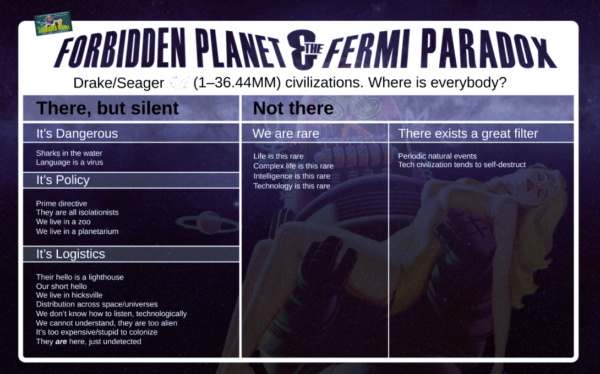
On the question of the existence of alien life, science fiction author Arthur C. Clarke made this philosophically trenchant quip: “Two possibilities exist: either we are alone in the Universe or we are not. Both are equally terrifying.” One might substitute the word “astonishing” or “overwhelming” for “terrifying,” but I suppose that depends on whether you just watched 2001, The Quiet Earth, or Mars Attacks. The question of why exactly we haven’t encountered any interstellar neighbors is phrased this way on Sci-Fi Interfaces:
“With 400 billion stars in our galaxy, and 400 billion galaxies in the observable universe, and billions of years of time since the start of the universe, even if only a very small fraction of stars produced advanced civilizations, where…is everybody? Why does space seem so devoid of life?”
That question is often called “The Fermi Paradox,” even though it isn’t really a paradox, in the traditional sense. Sci-Fi Interfaces explored the Fermi Paradox in relationship to science fiction in a recent post. Here’s more from Sci-Fi Interfaces:
About eleven years after Fermi asked his question, an astrophysicist named Frank Drake created a probabilistic equation by which we could come up with some answer about how many civilizations we might expect to find out there in the void. Now this isn’t like most equations for which you expect to get a single answer. This equation hopes to get us at least in the ballpark of the right right answer, say to an order of magnitude within the actual one. Just so we can know whether we’re talking about 10, 100, or 1,000 civilizations, etc. Drake’s equation has seven variables which we multiply together to produce an answer.
- SEO Powered Content & PR Distribution. Get Amplified Today.
- PlatoData.Network Vertical Generative Ai. Empower Yourself. Access Here.
- PlatoAiStream. Web3 Intelligence. Knowledge Amplified. Access Here.
- PlatoESG. Carbon, CleanTech, Energy, Environment, Solar, Waste Management. Access Here.
- PlatoHealth. Biotech and Clinical Trials Intelligence. Access Here.
- Source: https://blog.adafruit.com/2024/03/17/where-are-our-interstellar-neighbors-the-fermi-paradox-and-drakes-equation-scifisunday/



